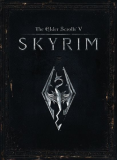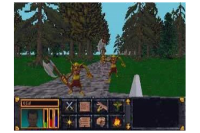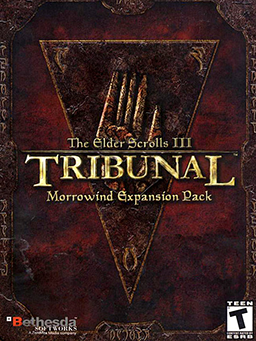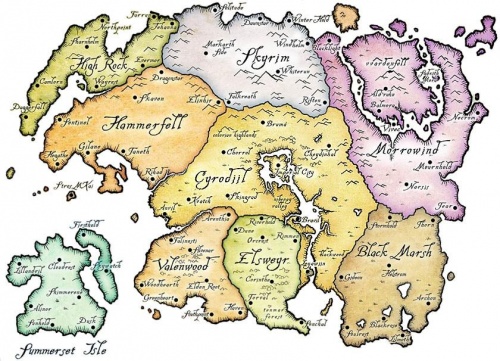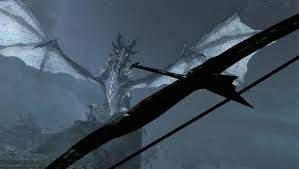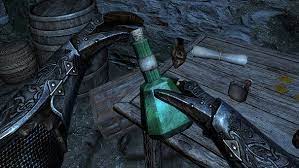Elder Scrolls
| Genre | Action role-playing |
| Gamming Style | Single player |
| Platform | PC Playstation 3/4 Xbox 360/One |
| Release Date | November 11, 2011 (Elder Scrolls V: Skyrim) [1] |
| Developer | Bethesda Game Studios [2] |
| Publisher | Bethesda Softworks |
| Website | http://www.elderscrolls.com/ |
The Elder Scrolls is a multi-platform action RPG video game series developed and published by Bethesda Softworks. Elder Scrolls games are famous for both their visual appeal and an open-world style that gives players almost complete freedom within the game to play their as they see fit[3]. The series currently consists of 5 games, beginning with the release of The Elder Scrolls: Arena in 1994 and the latest released on November 11, 2011, Skyrim[4]. In addition to the ethical issues associated with NPCs and virtual worlds, the modding tools included in the series from Morrowind on create an interesting set of ethical dilemmas. These dilemmas include protecting minors from adult content, as well as intellectual property rights.
Contents
- 1 Prior to the Series
- 2 World
- 3 The Elder Scrolls: Arena
- 4 The Elder Scrolls II: Daggerfall
- 5 The Elder Scrolls III: Morrowind
- 6 The Elder Scrolls III: Tribunal
- 7 The Elder Scrolls III: BloodMoon
- 8 The Elder Scrolls IV: Oblivion
- 9 The Elder Scrolls V: Skyrim
- 10 The Elder Scrolls Online
- 11 Ethical Implications
- 12 See Also
- 13 References
Prior to the Series
Before creating the iconic series, The Elder Scrolls, Bethesda primarily produced action and sports games. From 1988 to 1994 the video game development company released 6 sports games out of total of 10. Bethesda had games like “Hockey League Simulator”, “NCAA Basketball: Road to the Final Four ('91/'92 Edition)”, and Wayne Gretzky Hockey. When designers Ted Peterson and Vijay Lakshman pivoted to create Arena with little experience. Peterson recalls "I remember talking to the guys at Sir-Tech who were doing Wizardry VII: Crusaders of the Dark Savant at the time, and them literally laughing at us for thinking we could do it." [5]
World
The world of the series, Tamriel, is based on the world that the developers of Arena used in a Dungeons and Dragons game they played.[6]
Tamriel consists of nine provinces, each with it's own unique towns and race of people. The nine races include the Imperials, Khajiit, Bretons, Dunmer, Redguards, Altmer, Wood Elves, Nords, and Argonians. The races all have differentiating factors among them; for example, the Imperials are civilized humans while the Nords are more physically-built humans. The Khajiit are a feline race with high agility and stealth qualities and the Dunmer are dark elves who are proficient in magic.
The Elder Scrolls: Arena
The Elder Scrolls: Arena was the first game in The Elder Scrolls series. Its name derives from early in its development cycle when it was concieved of as a purely combat-oriented game.[7] The game became an open-world RPG as the developers added more role-playing aspects and reduced the player control characters down to a single individual because they felt these choices made the game more enjoyable.[8] However, the game retained the ill-fitting name "Arena" because game boxes and promotional materials had already already been printed. [9]
Despite influence from similar predecessors, Arena distinguished itself by combining first-person action with a very large immersive world. It introduced a unique control scheme where attacks were performed through slashing gestures of the cursor rather than single mouse clicks as in previous games.[10] The world was distinguished from other games by the fact that the user interacted with towns and villages by walking through them in first person rather than by using a menu.[11] The world also featured a calendar with corresponding seasonal weather, and both days and nights.[12] However, it also set itself apart through technical issues. The large number of bugs in the game was a severe problem both because it could make the game difficult to play, and because widespread internet access was not available as a method of distributing patches. The game also suffered performance issues on most machines due to high system requirements.[13] Despite these issues, the game became a cult success.
Development of Arena
Peterson and Lakshman started the development of Arena along with Julian Lefay. According to Peterson, Julian Lefay gave significant initiative towards the project and "really spear-headed the initial development of the series". [14] The three had extensive experience producing pen-and-paper role playing games such as Dungeons and Dragons which greatly influenced the development of the world of Tamriel. [15]
Story
Arena introduced Emperor Uriel Septim VII of Tamriel, a recurring character of the series. The first game of the series shows Septim kidnapped and imprisoned in the plane of oblivion while Imperial Battlemage Jagar Tharn impersonates him on the throne. The player is tasked with gathering the eight pieces of the Staff of Chaos to expose Tharn and save the Emperor.
Ethical Issues
The plot of the game itself presented few, if any, ethical concerns, aside from more trivial things like killing demons and wolves. However, it was one of the first games to be released that had heavy demands on players' computers, thus prohibiting those with lower-end machines from receiving good performance, or even playing at all. The surge of RPGs like Arena in following years kickstarted the trend of games being accessible only to those with current hardware.
The Elder Scrolls II: Daggerfall
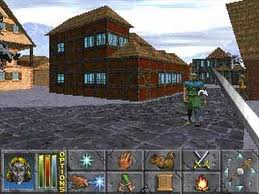
The Elder Scrolls II: Daggerfall takes place in High Rock, the Breton homeland. The Emperor sends the players to High Rock to track a letter which holds the location of the Mantella, a gem created from the soul of the Underking. This gem is the key to awakening the Numidium, a massive, iron golem. Everybody wants the Numidium for their own selfish gain, but the player can choose from six possible endings to determine the fate of Tamriel, and The Elder Scrolls history.
Development of Daggerfall
After the release of Area in March 1994, Peterson was assigned as lead designer for the development of the next installment in the series, Daggerfall. [17] It was released in August, 1996 in North America. Upon release several bugs were discovered by players leaving some negative criticism. This impacted the team to release a more finalized product in the future. [18]
What's Different?
The Elder Scrolls II: Daggerfall's game world gave the player the ability to explore a world that would equate to about half the size of Great Britain. And While many other games have specific endings, the ending to "Daggerfall" was dependent only on how the player navigated the game.
The Elder Scrolls III: Morrowind
The Elder Scrolls III: Morrowind begins on a stormy night on a boat. The player character is jarred out of a dream by nightmarish visions. It is revealed the player is actually a prisoner freed by none other than Uriel Septim VII. The Emperor wants the player to rendezvous with one of his agents, who inducts the player into the Blades, a secret order dedicated to the extermination of the evil deity, Dagoth Ur. The player continues to have odd dreams, which are revealed to be agents of Dagoth Ur attempting to infiltrate the player's mind.
The nomadic Ashlanders prophesize the reincarnation of Nerevar, the only force strong enough to take down Dagoth Ur. The player is Nerevar incarnate. After traveling to Red Mountain, the player and Dagoth Ur do battle. After Dagoth Ur is defeated the player breaks the Heart of Lorkhan, destroying the source of Dagoth Ur's power and killing him in the process.
Two expansion packs were made for The Elder Scrolls III: Morrowind, The Elder Scrolls III: Tribunal and The Elder Scrolls: Bloodmoon. They were both originally released as expansion packs and subsequently included in the release of the Game of the Year edition, which was released on October 31, 2003.[19] An important feature of these expansion packs is that they do not require the player to have finished, or even started the main quest of Morrowind.
Development of Morrowind
During the development of Daggerfall the team conceived the concept for Morrowind. The graphic resolution at the time used 32 bit textures and skeletal animation. [20] The project reportedly took “close to 100 man years to create” as Bethesda had tripled their staff to build a foundational tool set known as The Elder Scrolls Construction Set. This allowed the development team to scale up and down on the scope of their work. Daggerfall was released in North America on May 1, 2002. The president of Bethesda at the time, Vlatko Andonov, praised the project stating, “Morrowind will change the way we view role-playing games forever."[21]
Ethical Issues
Morrowind was the first edition of the Elder Scrolls series to introduce the concept of a bounty. In game it is trivial to steal goods from shopkeepers, kill the shopkeepers themselves, and just generally cause whatever mayhem the player chooses. Negative deeds increased the "bounty" that your player accumulates. The larger the bounty, the more frequently you will be pursued by city guards and disliked by citizens of Tamriel. When confronted, you are given the choice to go to jail (where you have one lockpick with which you can attempt to escape), pay the fine or fight your way out. When put in jail, or when you pay the fine, you are stripped of all stolen goods. In this way one almost becomes invested in the lifestyle they have given themselves in the game.
The Elder Scrolls III: Tribunal
The first expansion pack to be released, Tribunal takes place in Mournhold. A player cannot reach the city until they are randomly attacked by a member of the Dark Brotherhood in their sleep. Following this, if a player talks to any normal guard in the game and mentions the attack, they will be directed to Apelles Matius in the town of Ebonheart. He will then direct the player to Asciene Rane, also located in Ebonheart, who can teleport a player to the city. Tribunal introduced the ability to sort a player's journal by quest, making the objectives easier to identify and re-visit. Prior to the expansion pack, a player would have to search their journal for quest-specific information. The second important addition in Tribunal is the Museum of Artifacts. It allows the player to sell rare artifacts for half their value (up to 30,000 septims) which is more than typical merchants in the game can afford.[22]
The Elder Scrolls III: BloodMoon
The setting of Bloodmoon is an island called Solstheim, which is located Northwest of the mainland in Morrowind. It can be reached by:
- Crossing the water separating the island from the mainland using levitation, water walking, or swimming.
- Taking a boat across the water after speaking to the Khajiit S'virr in the town of Khuul.
A key change introduced by Bloodmoon is the ability of the player to become a werewolf. A player may become a werewolf via:[23]
- Contracting the disease Sanies Lupinus in combat with a werewolf and waiting three days.
- Progressing through Bloodmoon's main quest and not curing the disease after contracting it during the quest, the Siege of the Skaal Village.
- Completing Bloodmoon's main quest gives the player Hircine's ring, which turns the player into a werewolf while worn.
- Rather than fight a werewolf, a player can give their character the disease through the console and then wait three days. Hit ~ then type Player-> addspell "werewolf blood"
What's Different?
This was the first game in the series to be on multiple platforms: PC and Xbox. Although it was not the first game to break ground with this The Elder Scrolls III: Morrowind is the first game in the series to feature character creation and the ability to swap between third- and first-person views. “Morrowind” also took their multiple story lines to a new level, allowing up to hundreds of different stories to play out. “Morrowind” was also the first game in the series to have legitimate commercial success, selling over 4 million copies.
The Elder Scrolls IV: Oblivion
The Elder Scrolls history is completely upset within the first few minutes of The Elder Scrolls IV: Oblivion. The Emperor, Uriel Septim VII, entrusts the player with the task of finding Cyrodiil's lost heir, just as an assassin stabs and kills him. A covenant that kept the realm of Oblivion at bay was only in affect while a rightful heir wore the Amulet of Kings, which Septim gives the player with orders to find his long lost son. Players venture in and out of the realm of Oblivion, where hordes of demonic beasts are preparing to enter Cyrodiil, making sure to seal the gates, if only temporarily.
The Player finds Martin Septim, the rightful heir, and brings him back to the Imperial City only to find it under attack by the Daedric Prince of Destruction, Mehrunes Dagon. In a final act of epic redemption, Martin shatters the Amulet of Kings and merges with the Dragon-God of Time, Akatosh. The player and Martin, now an avatar of Akatosh, destroy Dagon and seal the gates to Oblivion forever, killing Martin in the process. This leaves the throne open once again.
What's Different?
“Oblivion” offered much of the same style of gameplay as its predecessors. Its one big change was that now the characters that were the environment of the game actually had roles. They no longer stood still; they slept, work, ate, etc.
The Elder Scrolls V: Skyrim
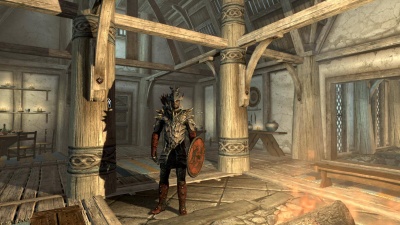
The game takes place 200 years after the events of Oblivion. The game takes set against a background of a civil war between the Nords, the largest ethnic in the titular province of Skyrim. The player begins the game shortly after the murder of the High King of Skyrim by Ulfric Stormcloak, the leader of the Stormcloaks, a rebel faction named after him. The murder is unusual because Stormcloak is rumored to have murdered the king with his voice. In addition to the king's murder and civil war, dragons have also returned to the land of Skyrim. Some characters believe a legendary dragon named Alduin will return to consume the world while others believe the a hero called the "Dragonborn" will appear as prophesied in the Elder Scrolls.[25]
What's Different?
Continuing in The Elder Scrolls fashion, the creators developed much more area for the player to explore. The map for Morrowind is estimated to be around 5 and 8 square miles in size, filled with random items, side stories, and unique events.[26] The biggest additions to these areas were the dungeons. They reportedly added over 150 unique dungeons for the players to explore.
The Elder Scrolls Online
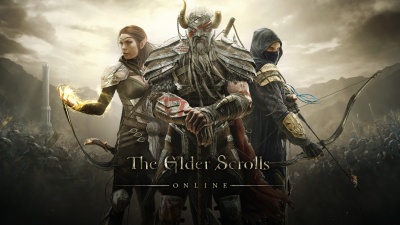
The Elder Scrolls Online is an MMORPG developed by ZeniMax Online Studios. It was released on April 4, 2014 for PC, and later on June 9, 2015 for PlayStation 4 and Xbox One. It is one of the few MMORPGs that exist cross-platform, on both PC and console platforms. However, despite the game being available for both PC and consoles, much like other cross-platform games, PC is on a different server group than Xbox One and PlayStation 4, meaning people who play TESO on PC cannot play with Xbox One and PlayStation 4 players.
In the Elder Scrolls Online, you are able to choose from ten total different races within the Elder Scrolls Universe: Nords, Redguards, Bretons, Imperials, Dark Elves, High Elves, Wood Elves, Orcs, Khajiiti, or Argonians. From there, the player must decide on a class for their character: a Dragonknight (DPS or Tank), a Sorcerer (DPS or Healer), a Nightblade (DPS or Healer), or a Templar (Tank, DPS, or Healer).
The Elder Scrolls Online can be purchased in the Steam store for $29.99. When the game was first released, there was a monthly subscription cost for $14.99 per month. However, the subscription requirement has since been removed, and the game is now free to play after the initial $29.99 base game purchase. The subscription cost has been replaced with an in-game microtransactions shop, however--players can now buy "crowns" for real money to spend on in-game items. Additionally, there is now a "plus membership" subscription option for $14.99 per month. While a plus membership is not required to play, a plus membership grants the player extra in-game perks, such as a monthly crown stipend, access to all DLC released within the player's membership, a 10% XP, crafting inspiration, crafting research, and gold bonus, a craft bag that holds unlimited crafting materials and is accessible from every character on the player's account, access to a dye station to dye clothing items and armor, and double the player house storage space.[28]
What's Different?
The Elder Scrolls Online is vastly different from any of the previous Elder Scrolls releases. For one, the genre of the game makes an enormous switch from singleplayer to MMORPG, which alters the general play style and feel of the series. Additionally, The Elder Scrolls Online was developed by an entirely different company than the other Elder Scrolls games--ZeniMax Online Studios developed TESO instead of Bethesda. This leads to some stylistic differences between the games, leading to criticism from some players.
Ethical Implications
Adult Mods
User created content, called a mod (short for modifier), first became a part of the Elder Scrolls games with the release of Daggerfall.[29] Players can make their own items, dungeons, cities, races, etc. with the use of official toolsets or their own software and add them into their games. Sharing mods over the internet is extremely popular as well, but this freedom has led to some controversy. The term TTP, or "time to penis", is an unofficial term used by game developers to describe the length of time before a game that allows users to create content to represent male genitals.[30]. The Elder Scrolls games, particularly Morrowind, Oblivion, and Skyrim, are infamous for having low TTPs[31] Adult content mods - featuring nudity, prostitution, animated sex, and the ability to kill children - quickly grew to be some of the most popular mods available.[32]
The Elder Scrolls IV: Oblivion was released in March 2006 with a rating of Teen by the Entertainment Software Ratings Board (ESRB). In under a month, a modder completely unaffiliated with the game's developers released a mod that enabled females to go topless as a protest of what she saw as societal prejudice and censorship of female anatomy.[33] Insiders within the industry were outraged in May of 2006 because after the reexamination, the ESRB decided to make the publisher of Oblivion, Bethesda, recall and release the game in new packaging.[34] The new package would feature a warning about possible nudity until the issue could be resolved. It is one of the few times in the history of the ESRB and the only time to that date that a mod had been the facilitator of change.
Although the first topless mod released for Oblivion was not created with sexual intent, many mods that were followed quickly. Because it is easy to lie to an age verification system, it can be argued that the game and the community it enables may risk harming children. This raises the question of whether the creators are responsible for policing the game players.
Promotion of Violence
In The Elder Scroll series, players are presented with the freedom to cause mayhem. Users have the choice to slaughter innocent civilians with very little in-game repercussion. Although the ruthless killing of civilians will alert guards to arrest the player, when players are strong enough, they are often times able to conduct mass murder without having to suffer consequences. This is further enhanced by the ability to quickly "save" the game and kill entire towns of people before reverting to that saved state, completely eliminating negative repercussions. Certain mods and add-ons have allowed players to turn all NPCs into children. A recent concern over the issue of players being able to malevolently slay children in Skyrim arose when a video was posted to YouTube depicting child NPCs being killed.[35] As a result of criticism during the game's development, children cannot be harmed by either the player or the world without installing mods to specifically allow this.[36]
Morrowind was the first edition of the Elder Scrolls series to introduce the concept of a bounty. In game it is trivial to steal goods from shopkeepers, kill the shopkeepers themselves, and just generally cause whatever mayhem the player chooses. Negative deeds increased the "bounty" that your player accumulates. The larger the bounty, the more frequently you will be pursued by city guards and disliked by citizens of Tamriel. When confronted, you are given the choice to go to jail (where you have one lockpick with which you can attempt to escape), pay the fine or fight your way out. When put in jail, or when you pay the fine, you are stripped of all stolen goods. In this way one almost becomes invested in the lifestyle they have given themselves in the game.
Racial Discrimination
Throughout the Elder Scroll series, there exists a complicated system of social hierarchy amongst the different races. Discrimination is apparent in how dialogues vary in ton and harshness depending on the social status of the NPC a player is conversing with. [37] This leads to ethical issues in which younger players of the game might see this as acceptable behavior in regards to how they interact with others in the real world. The separation of class is very much apparent as gameplay progresses in which you see the way in which classes interact with one another. There is also the issue in which the game portrays certain stereotypes throughout different classes which is harmful in itself to younger players who will ultimately bring those views with them to the real world.
Hardware Discrimination
The plot of the game itself presented few, if any, ethical concerns, aside from more trivial things like killing demons and wolves. However, it was one of the first games to be released that had heavy demands on players' computers, thus prohibiting those with lower-end machines from receiving good performance, or even playing at all. The surge of RPGs like Arena in following years kickstarted the trend of games being accessible only to those with current hardware.
On the other hand, mods have since been released to accommodate players with lower graphical specs. These mods lower the in-game graphics settings to a point past what the pre-existing settings call for, allowing players with sub-par hardware to access the game. On the other side, there are mods such as high-quality texture pack mods that increase the graphical settings past their pre-existing settings for players with higher-end hardware. All in all, The Elder Scrolls: Skyrim is a generally accommodating game for players of different hardware specs.
See Also
References
- ↑ "The Elder Scrolls V: Skyrim", The Elder Scrolls Wiki, N.D. [1]
- ↑ "An Incredibly In-Depth Look At the Making of Skyrim", Kirk Hamilton, [2]
- ↑ "The evolution of The Elder Scrolls", Jody Macgregor, 03 November 2016 [3]
- ↑ "Let's Rank the Elder Scrolls Games, Best to Worst", Kirk Hamilton, 04 February 2013 [4]
- ↑ Before Elder Scrolls https://www.pcgamer.com/the-evolution-of-the-elder-scrolls/
- ↑ "Arena - Behind the Scenes", Internet Archive Wayback Machine, 09 June 2007 [5]
- ↑ "The Elder Scrolls: Arena", Marino, 07 July 2016 [6]
- ↑ "The Elder Scrolls: Arena", Marino, 07 July 2016 [7]
- ↑ "The Elder Scrolls: Arena", Marino, 07 July 2016 [8]
- ↑ "Video Game History - The Elder Scrolls: Arena", Rowan Kaiser, 10 March 2011 [9]
- ↑ "Video Game History - The Elder Scrolls: Arena", Rowan Kaiser, 10 March 2011 [10]
- ↑ "Video Game History - The Elder Scrolls: Arena", Rowan Kaiser, 10 March 2011 [11]
- ↑ "The Elder Scrolls: Arena", Marino, 07 July 2016 [12]
- ↑ Julian Lefay https://web.archive.org/web/20071013193716/http://planetelderscrolls.gamespy.com/View.php?view=Articles.Detail&id=12
- ↑ DnD https://web.archive.org/web/20071013193716/http://planetelderscrolls.gamespy.com/View.php?view=Articles.Detail&id=12
- ↑ "Let's Play Daggerfall! Part 9: In Which We Steal (And Fight Walls)", MechMantis, February 2009 [13]
- ↑ https://web.archive.org/web/20071013193716/http://planetelderscrolls.gamespy.com/View.php?view=Articles.Detail&id=12
- ↑ https://web.archive.org/web/20070509175133/http://www.elderscrolls.com/tenth_anniv/tenth_anniv-daggerfall.htm
- ↑ "Bethesda Announces Morrowind Game of the Year Edition, Gabriel Putnam, 2003 [14]
- ↑ Development of Morrowind https://web.archive.org/web/20071019071012/http://planetelderscrolls.gamespy.com/View.php?view=Articles.Detail&id=27
- ↑ Release of Morrowind https://web.archive.org/web/20020812193715/http://www.elderscrolls.com/news/press_042302.htm
- ↑ "Bethesda Announces Morrowind Game of the Year Edition, Gabriel Putnam, 2003 [15]
- ↑ "Bloodmoon: Werewolf", The Unofficial Elder Scrolls Pages, 31 May 2017 [16]
- ↑ http://junglebiscuit.com/node/91
- ↑ UESP Skyrim UESP Skyrim Overview
- ↑ Sutton, Matt, How Large is Skyrim's world?, Quora https://www.quora.com/How-large-is-Skyrims-overworld
- ↑ http://files.elderscrollsonline.com/uploads/blogs/a96753c85368b44e7952aceba7de856d.jpg
- ↑ Online: ESO Plus http://en.uesp.net/wiki/Online:ESO_Plus
- ↑ AndyFall - The Unofficial Elder Scrolls Pages | http://www.uesp.net/wiki/Daggerfall:AndyFall
- ↑ TTP - Urban Dictionary | http://www.urbandictionary.com/define.php?term=ttp
- ↑ Sixteen things modders will bring to the Elder Scrolls V: Skyrim - Dual Shockers | http://www.dualshockers.com/2011/09/19/sixteen-things-modders-will-bring-to-the-elder-scrolls-v-skyrim/
- ↑ Skyrim - Nexus Mods | http://skyrim.nexusmods.com/mods/topalltime/?adult=0
- ↑ The Breasts that Broke the Game, [17]
- ↑ Breaking: ESRB Pulls, Re-Rates Oblivion To Mature, [18]
- ↑ The Elder Scrolls 5 Skyrim's controversial child-killing mod - Game Bandits | http://www.gamebandits.com/news/pc/the-elder-scrolls-5-skyrim-controversial-child-killing-mod-24141/
- ↑ November 20,2011. Kotaku.Mod allows children to be killed in Skyrim
- ↑ December 1, 2011. Escapist Magazine. Racism in Skyrim?
